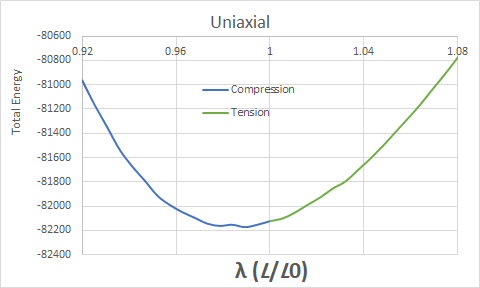Dear all,
Hi!
I have a simulation box of Aluminum which was chosen as 20x20x20 unit cells to properly enforce periodic boundary conditions (PBC) in all directions. In order to system equilibration, first, the entire system was equilibrated at temperature of 300K using NVT dynamics, for 25 ps. Time step Δt= 1fs is used throughout the simulations. After that, the relaxation was continued with the same temperature for 25 ps using isothermal-isobaric (NPT) ensemble.
It is worth to note that, in all equilibration stages, linear momentum was zeroed by subtracting the center-of-mass velocity of the group from each atom.
To calculate the total energy, a simple uniaxial compression strain rate of -0.0053 ps-1 (strain increases -0.0053 every picosecond) was applied along the [100] (x-direction) at 300K which leads to nonzero stress components σxx, σyy, σzz. The strains in the y- and z-directions were both controlled to be zero under the NVT ensemble. Then a simple uniaxial tensile strain rate of 0.0053 ps-1(strain increases 0.0053 every picosecond) was applied along the [100] (x-direction) at 300K.
Total Energy- Lambda curve is attached.
Now, I want to know why our minimum energy is not at λ=1? What I am saying is, why does total energy drop in Compression part at first?
